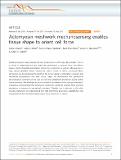Actomyosin meshwork mechanosensing enables tissue shape to orient cell force
Author(s)
Miller, Callie J.; Ermentrout, Bard; Davidson, Lance A.; Chanet, Soline; Vaishnav, Eeshit Dhaval; Martin, Adam C; ... Show more Show less
Downloadncomms15014.pdf (3.311Mb)
PUBLISHER_POLICY
Publisher Policy
Article is made available in accordance with the publisher's policy and may be subject to US copyright law. Please refer to the publisher's site for terms of use.
Terms of use
Metadata
Show full item recordAbstract
Sculpting organism shape requires that cells produce forces with proper directionality. Thus, it is critical to understand how cells orient the cytoskeleton to produce forces that deform tissues. During Drosophila gastrulation, actomyosin contraction in ventral cells generates a long, narrow epithelial furrow, termed the ventral furrow, in which actomyosin fibres and tension are directed along the length of the furrow. Using a combination of genetic and mechanical perturbations that alter tissue shape, we demonstrate that geometrical and mechanical constraints act as cues to orient the cytoskeleton and tension during ventral furrow formation. We developed an in silico model of two-dimensional actomyosin meshwork contraction, demonstrating that actomyosin meshworks exhibit an inherent force orienting mechanism in response to mechanical constraints. Together, our in vivo and in silico data provide a framework for understanding how cells orient force generation, establishing a role for geometrical and mechanical patterning of force production in tissues.
Date issued
2017-05Department
Massachusetts Institute of Technology. Department of BiologyJournal
Nature Communications
Publisher
Nature Publishing Group
Citation
Chanet, Soline et al. “Actomyosin Meshwork Mechanosensing Enables Tissue Shape to Orient Cell Force.” Nature Communications 8 (May 2017): 15014 © 2017 The Author(s)
Version: Final published version
ISSN
2041-1723